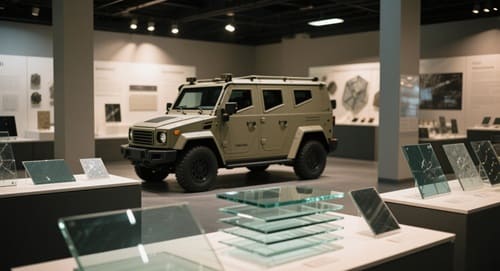How Do Advanced Bulletproof Materials Compare With Traditional Bulletproof Materials?
In a world where safety and protection have become more vital than ever, bulletproof materials are at the forefront of innovation. From personal body armor to armored vehicles and bullet-resistant glass, the materials used for protection are advancing rapidly. These high-performance materials are not only crucial for law enforcement and military applications but are also increasingly found in civilian and industrial settings.
As new threats emerge and technology advances, the demand for improved, lighter, and more adaptable bulletproof materials is increasing. This article explores the science, types, performance, and future of bulletproof materials used across various sectors.
At Advanced Ceramic Hub, we specialize in high-quality ceramic products, ensuring optimal performance for industrial and scientific applications.
What Defines a Bulletproof Material?
Bulletproof materials aren’t defined by a single property but by a combination of characteristics that enable them to resist penetration and absorb high-energy impacts. These materials must be exceptionally hard, yet lightweight enough to be practical in applications like vests and vehicles. They are also often layered or laminated to enhance performance and dissipate force across multiple surfaces.
Common Properties of Bulletproof Materials:
| Property | Description |
| Hardness | Resists deformation or penetration |
| Toughness | Absorbs energy without fracturing |
| Low Density | Keeps the material lightweight |
| Thermal Stability | Maintains integrity under heat stress |
| Multi-layer Capability | Works effectively in laminated structures |
An effective bulletproof material must also exhibit resilience to repeated strikes and maintain protection across different environmental conditions. It’s the balance between hardness and energy absorption that makes a material truly bullet-resistant.
What Materials Are Used in Personal Body Armor?
Body armor needs to be lightweight, flexible, and capable of stopping handgun and rifle rounds. The most common bulletproof materials in wearable armor include high-strength fibers, ceramics, and composites. Soft body armor typically utilizes woven fibers, whereas hard armor incorporates ceramic plates backed by polymer layers.
Common Materials in Body Armor:
| Material | Type | Usage |
| Kevlar | Aramid fiber | Soft armor, stab-resistant vests |
| Dyneema | UHMWPE | Lightweight ballistic plates |
| Ceramic Plates | Alumina, SiC | Rifle-rated hard armor |
| Graphene-based | Nano-composite | Research and prototype armors |
The material choice affects not just the protection level but also comfort, weight distribution, and mobility. With advancements in fiber science, manufacturers are developing hybrid systems that combine flexibility and high-impact resistance.
What Bulletproof Materials Are Used in Vehicles?
Vehicle armor must protect large surface areas while minimizing weight to maintain mobility. Bulletproof materials used in vehicles range from traditional steel to advanced composites and ceramics. Armored cars, military trucks, and even helicopters use multi-layered systems to balance protection and performance.
Armor Materials in Vehicles:
| Component | Common Material | Function |
| Panels | Hardened steel, ceramics | Resist ballistic penetration |
| Glass | Laminated polycarbonate | Stop bullets and resist shattering |
| Undercarriage | Kevlar, composites | Mine and IED protection |
| Interior lining | Foam, aramid | Reduce spall and shockwaves |
Different vehicle zones demand specific protective materials. For instance, the engine bay might use heavier armor than door panels, while transparent areas like windows require optically clear yet impact-resistant glass composites.
What Makes Bulletproof Glass Effective?
Bulletproof glass is not a single layer but a multi-layered composite of glass and polymer. The outer layers absorb the impact, while the inner layers prevent shattering. Bulletproof glass varies in thickness and strength depending on the threat level.
Layers of Bulletproof Glass:
| Layer Type | Material | Purpose |
| Outer Layer | Tempered Glass | Initial impact resistance |
| Interlayer | PVB or SGP | Energy absorption and bonding |
| Inner Layer | Polycarbonate | Prevents spall and holds structure |
The layering technique allows bulletproof glass to maintain visibility while providing strong resistance to both ballistic threats and forced entry. It is often tested to meet standards like UL 752 or NIJ ratings, depending on the application.
How Do Ceramic Bulletproof Materials Compare?
Ceramic materials like alumina (Al₂O₃), silicon carbide (SiC), and boron carbide (B₄C) are used in hard armor because of their extreme hardness and low density. They fracture upon impact, dispersing the energy and blunting the projectile.
Ceramic vs. Non-Ceramic Bulletproof Materials:
| Material | Weight | Hardness | Application Area |
| Alumina | Medium | High | Body armor plates |
| Silicon Carbide | Light | Very High | Helicopter armor |
| Steel | Heavy | High | Vehicle armor |
| UHMWPE | Very Light | Moderate | Civilian body armor |
Though brittle, ceramics are extremely effective when used with a backing layer that absorbs the residual energy. Their use is especially common in high-risk zones where weight and impact resistance must be balanced.
Explore our high-quality ceramic products.
How Do Bulletproof Materials Perform Under Different Conditions?
Bulletproof materials often operate in extreme environments, from high temperatures in deserts to humidity in tropical areas. Their ability to retain structural integrity under such conditions is a major factor in their long-term effectiveness.
Environmental Resistance Comparison:
| Material | Heat Resistance | Moisture Resistance | UV Stability |
| Kevlar | Medium | Low | Moderate |
| UHMWPE | High | High | Low |
| Ceramics | Very High | High | High |
A material’s durability determines its field reliability. For example, UHMWPE may warp at elevated temperatures, while ceramics and aramid fibers retain strength under prolonged thermal stress and exposure.
How Do Bulletproof Materials Compare With Traditional Materials?
Traditional materials like steel and aluminum have been used for decades, but newer bulletproof materials offer better performance at reduced weight. The table below compares these on critical factors.
Traditional vs Bulletproof Materials:
| Property | Traditional Steel | Bulletproof Ceramics | UHMWPE |
| Density | High | Medium | Low |
| Protection Level | Moderate | High | Moderate |
| Cost | Low | High | High |
Modern protective systems aim to minimize weight while maximizing coverage and resistance. This evolution makes advanced materials far more suitable for mobile or wearable applications.
Request a custom quote for ceramic product.
What Is the Future of Bulletproof Materials?
The future of bulletproof materials lies in innovation. Nanotechnology, smart materials, and bio-inspired designs are opening new possibilities. Research into self-healing coatings and adaptive armor systems could revolutionize protection.
Emerging Trends:
- Smart textiles with embedded sensors
- Graphene-reinforced composites
- Artificial nacre-like layering
- AI-optimized material layering
These next-generation materials aim to deliver responsive protection—armor that can adapt to the threat in real-time or repair itself after damage. The fusion of AI and material science is pushing boundaries like never before.
FAQ
| Question | Answer |
| Can Kevlar stop rifle bullets? | Only when backed by ceramic or metal plates |
| Is thicker glass always better? | No, lamination and material choice matter more |
| Are all armored cars extremely heavy? | Not necessarily; modern composites reduce weight |
| Do bulletproof plates last forever? | No, most degrade after impact or over time |
Conclusion
As threats evolve, so must the materials designed to stop them. Bulletproof materials today are not just hardened steel or thick glass—they are advanced composites, engineered fabrics, and cutting-edge ceramics optimized for maximum protection. Whether for body armor, vehicles, or architectural glass, selecting the right material depends on the threat level, application, and environmental demands.
Innovation continues to drive the industry forward. With smart materials, nanotechnology, and hybrid designs, bulletproof solutions are becoming more efficient, lighter, and accessible. Shortly, these materials won’t just stop bullets—they’ll change how we define protection itself.
Looking for high-quality ceramic products? Contact us today!

